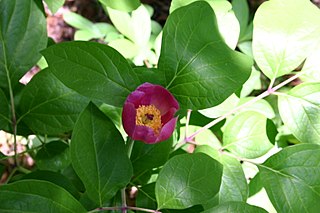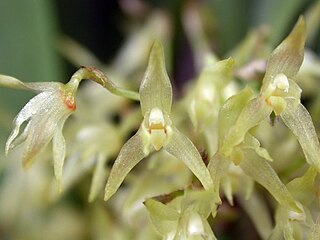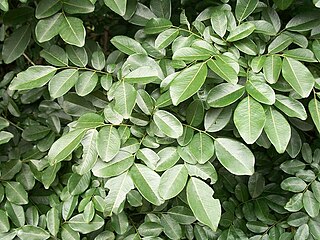Sycamore is a name which has been applied to several types of trees, but with somewhat similar leaf forms. The name derives from the ancient Greek συκόμορος (sūkomoros) meaning "fig-mulberry".

Magnolia officinalis is a species of Magnolia native to the mountains and valleys of China at altitudes of 300–1500 m.

Packera obovata, commonly known as roundleaf ragwort, spoon-leaved ragwort, roundleaf groundsel, or squaw-weed, is an erect perennial herb in the Asteraceae (aster) family native to eastern North America. It was previously called Senecio obovatus. Basal and lower leaves are obovate with toothed margins, while upper leaves are pinnately divided. The ray flowers are yellow and the disk flowers orange-yellow, the inflorescences being held well above the foliage.

Picea obovata, the Siberian spruce, is a spruce native to Siberia, from the Ural Mountains east to Magadan Oblast, and from the Arctic tree line south to the Altay Mountains in northwestern Mongolia.

Banksia obovata, commonly known as wedge-leaved dryandra, is a species of shrub that is endemic to Western Australia. It has hairy stems, serrated, wedge-shaped to egg-shaped leaves with the lower end towards the base, cream-coloured or pale yellow flowers in heads of up to 100, and egg-shaped follicles. It is found in near-coastal areas in the south of the state.
Dirichletia obovata, synonym Carphalea obovata, is a species of plant in the family Rubiaceae. It is endemic to Socotra. Its natural habitat is subtropical or tropical dry forests.
Melicope obovata, also called Makawao melicope or ovate melicope, was a species of plant in the family Rutaceae. It was endemic to the Hawaiian Islands.

Paeonia obovata is a perennial herbaceous species of peony growing 30–70 cm high. It has white, pink or purple-red flowers and its lower leaves consist of no more than nine leaflets or segments. In English it is sometimes called woodland peony. It grows naturally in warm-temperate to cold China, including Manchuria, and in Korea, Japan, Far Eastern Russia and on Sakhalin.

Buchanania obovata is a small to medium-sized understorey tree in woodlands native to northern Australia, in particular in Arnhem Land in the Northern Territory. Common names include green plum and wild mango.

Kandelia obovata is a species of plant in the Rhizophoraceae family, i.e. a kind of mangrove. It is found in Vietnam, Natuna Islands of Indonesia, Southern China, Hong Kong, Taiwan, and Japan. Its presence in the Philippines is possible but not confirmed.

Charpentiera obovata, known as broadleaf pāpala, is a species of flowering shrub or small tree in the family Amaranthaceae, that is endemic to Hawaiʻi. It inhabits dry, coastal mesic, mixed mesic, and wet forests at elevations of 190–1,750 metres (620–5,740 ft) on all main islands. C. obovata reaches a height of 4.6–9.1 metres (15–30 ft) and a trunk diameter of 0.1–0.6 metres (0.33–1.97 ft).

Cryptocarya obovata is a species of laurel growing on basaltic and fertile alluvial soils in eastern Australian rainforests. It is found from Wyong in New South Wales to Gympie in the state of Queensland. Extinct in the Illawarra region, allegedly last seen in the Illawarra in 1818 by Allan Cunningham. The species was included in the Prodromus Florae Novae Hollandiae et Insulae Van Diemen, 402 (1810)

Anathallis obovata, the South American bonnet orchid, is a species of orchid.

Planchonella obovata is a species of tree in the family Sapotaceae. The common name in Australia is the northern yellow boxwood. It occurs in many parts of south-east Asia, Micronesia, and on islands of the Indian Ocean, and has local common names there.

Dalbergia obovata is a robust shrub or climber in the family Fabaceae, and is native to Southern Africa.

Cornutia obovata is a rare species of tree in the mint family, and formerly considered a member of the verbena family. It is endemic to forested slopes in Puerto Rico, where its common names are capá jigüerilla, nigua, and palo de nigua. When it was added to the endangered species list of the United States in 1988 there were only seven individuals known to remain in the wild. By 1998 there were eight plants known. This is considered one population divided amongst a few locations in the mountain forests of the island.

Obovatol is a biphenolic anti-inflammatory, anxiolytic, and nootropic isolated from the bark of Magnolia obovata. It is a biphenyl lignan.

Pterolophia is a genus of longhorn beetles of the subfamily Lamiinae, containing the following species:
Ericameria obovata, or Rydberg's goldenbush, is a North American species of flowering shrubs in the family Asteraceae. It has been found only in the state of Utah in the western United States.














